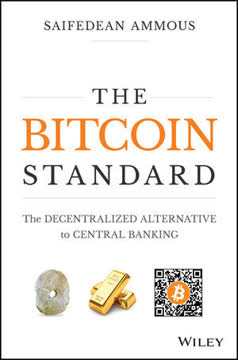Key Takeaways
1. Blockchain: A Distributed Ledger for Trust and Transparency
The core problem to be solved by the blockchain is achieving and maintaining integrity in a purely distributed peer-to-peer system that consists of an unknown number of peers with unknown reliability and trustworthiness.
Decentralized trust. Blockchain technology revolutionizes how we establish trust in digital environments. By distributing a ledger across a network of computers, it eliminates the need for central authorities and creates a transparent, tamper-resistant record of transactions.
Key features:
- Distributed: No single point of failure
- Transparent: All transactions are visible to network participants
- Immutable: Once recorded, data cannot be altered without consensus
- Secure: Cryptographic techniques ensure data integrity and user authentication
The blockchain's ability to maintain integrity in an open, untrusted environment makes it a powerful tool for various applications beyond cryptocurrencies, including supply chain management, voting systems, and digital identity verification.
2. Cryptographic Hash Functions: The Digital Fingerprint
Cryptographic hash functions create digital fingerprints for any kind of data.
Data integrity cornerstone. Hash functions are fundamental to blockchain's security and data integrity. They transform input data of any size into a fixed-length output, creating a unique "fingerprint" for that data.
Key properties of cryptographic hash functions:
- Deterministic: Same input always produces the same output
- Quick computation: Easy to calculate for any input
- Pre-image resistance: Infeasible to determine input from the hash
- Collision resistance: Extremely unlikely to find two inputs with the same hash
- Avalanche effect: Small changes in input cause significant changes in output
These properties ensure that any tampering with blockchain data is immediately detectable, as even the slightest modification would result in a completely different hash value.
3. Public-Private Key Cryptography: Securing Transactions
Asymmetric cryptography always uses two complementary keys. But there is a trick to this: cypher text created with one of these keys can only be decrypted with the other key and vice versa.
Digital signatures and encryption. Public-private key cryptography forms the backbone of blockchain security, enabling secure transactions and user authentication without revealing sensitive information.
How it works:
- Each user has a public key (shared openly) and a private key (kept secret)
- Public key can be used to encrypt messages or verify signatures
- Private key is used to decrypt messages or create digital signatures
This system allows users to:
- Prove ownership of assets without revealing private keys
- Sign transactions securely, ensuring non-repudiation
- Communicate securely in an open network
By leveraging asymmetric cryptography, blockchain creates a secure environment for peer-to-peer transactions without the need for trusted intermediaries.
4. The Blockchain Data Structure: Immutable and Append-Only
The blockchain-data-structure actually does not look like a straight chain, instead it looks more like a tree or a columnar cactus, a blockcactus so to speak.
Tamper-evident ledger. The blockchain's unique data structure ensures the integrity and chronological order of all transactions, making it extremely difficult to alter historical data without detection.
Key components:
- Blocks: Containers for batches of validated transactions
- Hash pointers: Link each block to its predecessor, forming a chain
- Merkle trees: Efficiently summarize all transactions in a block
This structure creates an immutable, append-only ledger where:
- New data can only be added to the end of the chain
- Any attempt to modify past data invalidates all subsequent blocks
- The entire transaction history can be verified from the latest block
The tree-like structure allows for temporary forks, which are resolved through consensus mechanisms, ensuring that all network participants eventually agree on a single version of the truth.
5. Consensus Mechanisms: Ensuring Agreement in a Decentralized Network
Distributed consensus is an agreement among the members of a purely distributed peer-to-peer system in a collective decision-making problem.
Decentralized decision-making. Consensus mechanisms are crucial for maintaining the integrity and consistency of the blockchain across all network participants without central authority.
Popular consensus mechanisms:
- Proof of Work (PoW): Miners solve complex puzzles to validate blocks
- Proof of Stake (PoS): Validators are chosen based on their cryptocurrency holdings
- Delegated Proof of Stake (DPoS): Token holders vote for a limited number of validators
- Practical Byzantine Fault Tolerance (PBFT): Nodes communicate to reach consensus
These mechanisms ensure that:
- All nodes agree on the state of the ledger
- Double-spending and other fraudulent activities are prevented
- The network remains resistant to attacks and manipulation
By allowing a distributed network to reach agreement without central coordination, consensus mechanisms enable the decentralized trust that is fundamental to blockchain technology.
6. Mining and Incentives: Maintaining Network Integrity
The blockchain utilizes fees for compensating its peers for contributing to the integrity of the system.
Economic incentives for security. Mining and reward systems play a crucial role in maintaining the integrity and security of blockchain networks by aligning participants' economic interests with the network's health.
Key aspects of mining and incentives:
- Block rewards: Miners receive newly created cryptocurrency for validating blocks
- Transaction fees: Users pay fees to prioritize their transactions
- Difficulty adjustment: Network automatically adjusts mining difficulty to maintain consistent block times
These mechanisms ensure that:
- There's a continuous incentive to participate in network maintenance
- The cost of attacking the network outweighs potential benefits
- The cryptocurrency supply is regulated in a predictable manner
By creating a system where maintaining network integrity is economically rewarding, blockchain technology creates a self-sustaining, secure environment for digital transactions and data storage.
7. Beyond Cryptocurrencies: Diverse Applications of Blockchain Technology
The blockchain can be considered a purely distributed data store with additional properties such as being immutable, append-only, ordered, time-stamped, and eventually consistent.
Versatile technology. While often associated with cryptocurrencies, blockchain's unique properties make it suitable for a wide range of applications across various industries.
Potential applications:
- Supply chain management: Tracking product origins and movements
- Healthcare: Secure, interoperable patient records
- Voting systems: Transparent, tamper-resistant electronic voting
- Digital identity: Self-sovereign identity management
- Intellectual property: Proof of creation and licensing
- Real estate: Property title management and transfer
- Energy trading: Peer-to-peer energy markets
These applications leverage blockchain's key features:
- Immutability: Ensuring data integrity
- Transparency: Providing auditable records
- Decentralization: Reducing single points of failure
- Smart contracts: Automating complex processes
As the technology matures, we can expect to see blockchain revolutionize numerous sectors by providing secure, transparent, and efficient solutions to longstanding challenges.
8. Blockchain Types: Public, Private, Permissioned, and Permissionless
Combining these restrictions pairwise led to the emergence of four different kinds of blockchains.
Tailored solutions. Different blockchain types have emerged to address various needs and use cases, balancing factors such as privacy, scalability, and control.
Four main types of blockchains:
- Public Permissionless: Open to all, anyone can participate (e.g., Bitcoin)
- Public Permissioned: Open to all, but with restricted participation roles
- Private Permissionless: Restricted access, but open participation within the network
- Private Permissioned: Restricted access and participation, often used in enterprise solutions
Key considerations when choosing a blockchain type:
- Transparency requirements
- Scalability needs
- Regulatory compliance
- Privacy concerns
- Control over network participants
By offering different levels of openness and control, these blockchain types enable the technology to be adapted for a wide range of applications, from fully decentralized cryptocurrencies to tightly controlled enterprise solutions.
9. Scalability and Privacy: Challenges and Solutions in Blockchain Development
The blockchain inherently contains the following conflicts: Transparency vs. privacy and Security vs. speed.
Overcoming limitations. As blockchain technology matures, researchers and developers are working to address its main challenges: scalability and privacy.
Scalability solutions:
- Layer 2 protocols: Off-chain transactions (e.g., Lightning Network)
- Sharding: Dividing the network into smaller, manageable parts
- Alternative consensus mechanisms: More efficient than Proof of Work
Privacy enhancements:
- Zero-knowledge proofs: Verifying transactions without revealing details
- Ring signatures: Obscuring transaction origins
- Privacy coins: Cryptocurrencies with built-in privacy features
These advancements aim to:
- Increase transaction throughput
- Reduce confirmation times
- Lower transaction costs
- Enhance user privacy
- Improve overall network efficiency
By addressing these challenges, blockchain technology is evolving to meet the demands of widespread adoption and more complex use cases, paving the way for its integration into mainstream systems and processes.
Last updated:
FAQ
What's Blockchain Basics about?
- Non-Technical Introduction: Blockchain Basics by Daniel Drescher offers a non-technical introduction to blockchain, breaking down complex concepts into 25 understandable steps.
- Focus on Concepts: The book emphasizes understanding the underlying concepts of blockchain rather than specific applications like Bitcoin, making it accessible to a broader audience.
- Ownership and Applications: It explores how blockchain manages ownership and transfer of assets securely, addressing challenges like double spending and showcasing various applications.
Why should I read Blockchain Basics?
- Comprehensive Understanding: The book bridges the gap between technical and non-technical literature, providing a conceptual understanding necessary for evaluating blockchain applications.
- Accessible Language: Drescher uses a conversational style without heavy jargon, making it suitable for readers without a technical background.
- Incremental Learning: The structured approach allows readers to build knowledge step-by-step, ensuring a solid grasp of blockchain fundamentals.
What are the key takeaways of Blockchain Basics?
- Understanding Ownership: The book explains how blockchain technology can manage ownership through a decentralized ledger, emphasizing integrity and trust.
- Immutability and Security: It highlights the importance of immutability in blockchain, making it resistant to tampering and fraud, crucial for applications like cryptocurrencies.
- Peer-to-Peer Architecture: The decentralized nature of blockchain allows for peer-to-peer transactions without intermediaries, leading to reduced costs and increased efficiency.
How does Blockchain Basics define ownership?
- Three Elements of Ownership: Ownership is defined through identification of the owner, identification of the object, and mapping the owner to the object.
- Transaction History: The book emphasizes maintaining a history of transactions to clarify ownership, rather than relying solely on inventory data.
- Role of Ledgers: Ledgers document ownership and transfers, ensuring that ownership claims are verifiable.
What is the double spending problem discussed in Blockchain Basics?
- Definition: The double spending problem refers to the risk of a digital currency being spent more than once, a significant concern in decentralized systems.
- Impact on Integrity: If integrity is violated through double spending, it undermines trust in the blockchain system, leading to potential financial losses.
- Blockchain Solution: Blockchain technology addresses this issue by ensuring all transactions are recorded in a way that prevents double spending.
How does Blockchain Basics explain the concept of digital signatures?
- Authorization of Transactions: Digital signatures allow the owner of an account to authorize transactions, ensuring only they can transfer ownership.
- Public-Private Key Cryptography: Digital signatures utilize asymmetric cryptography, where a private key signs a transaction, and a public key verifies it.
- Proof of Agreement: A digital signature serves as proof that the owner agrees with the transaction details, similar to a handwritten signature on a document.
What is the significance of hash functions in Blockchain Basics?
- Data Integrity: Hash functions create unique digital fingerprints for data, allowing for quick comparisons and detection of changes, crucial for maintaining blockchain integrity.
- Collision Resistance: Cryptographic hash functions are designed to be collision-resistant, making it highly unlikely for two different inputs to produce the same hash value.
- Change Detection: Hash values detect unauthorized changes in transaction data, ensuring any manipulation is easily identified.
What are the limitations of blockchain technology as discussed in Blockchain Basics?
- Scalability Issues: The book addresses challenges related to scalability, particularly how blockchain can struggle to handle a high volume of transactions efficiently.
- Energy Consumption: It discusses the energy-intensive nature of certain consensus mechanisms, such as proof of work, which can be a drawback for widespread adoption.
- Regulatory Concerns: Potential legal and regulatory challenges could impact the implementation and acceptance of blockchain technology.
How does Blockchain Basics describe the blockchain-data-structure?
- Chain of Blocks: The blockchain-data-structure is a series of blocks, each containing a header and a Merkle tree of transaction data, linked by hash references.
- Order Preservation: The structure ensures that the order of transactions is preserved, crucial for maintaining data integrity.
- Change Sensitivity: The blockchain-data-structure is designed to be change-sensitive, meaning any alteration to the data will invalidate the entire structure.
How does the blockchain ensure data integrity according to Blockchain Basics?
- Immutable Data Structure: Blockchain uses an immutable append-only data structure, meaning once data is added, it cannot be changed or deleted.
- Hashing Mechanism: Each block contains a cryptographic hash of the previous block, creating a chain that makes tampering easily detectable.
- Consensus Algorithm: A consensus algorithm, such as proof of work, validates transactions and adds new blocks, deterring malicious actors from manipulating data.
What are the different types of blockchains mentioned in Blockchain Basics?
- Public Blockchains: Open to everyone, allowing any user to read and write data, exemplifying decentralization and transparency.
- Private Blockchains: Restrict access to a preselected group of users, often used in commercial contexts where privacy and control are prioritized.
- Permissioned Blockchains: Grant writing access only to a limited group of trusted nodes, enhancing security and efficiency while leveraging blockchain benefits.
What are the practical applications of blockchain technology outlined in Blockchain Basics?
- Cryptocurrencies: Blockchain underpins cryptocurrencies, enabling secure and decentralized transactions, gaining significant attention and adoption.
- Digital Identity: Blockchain can create secure digital identities, allowing individuals to manage personal information without centralized authorities.
- Notary Services: The technology can be applied to notary services, providing a secure way to digitize and verify documents, streamlining processes.
Review Summary
Blockchain Basics is praised for its clear explanations of complex concepts using metaphors and repetition. Readers appreciate its non-technical approach and systematic breakdown of blockchain technology. Many find it an excellent introduction for beginners, though some technical readers may find it verbose. The book is commended for its structure, outlines, and comprehensive coverage of blockchain fundamentals. While some critics note its dry style and repetitiveness, most reviewers highly recommend it for those seeking to understand blockchain technology without delving into cryptocurrencies specifically.
Similar Books










Download PDF
Download EPUB
.epub digital book format is ideal for reading ebooks on phones, tablets, and e-readers.




